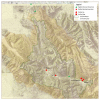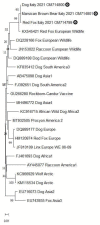Molecular Detection and Phylogenetic Analysis of Canine Distemper Virus in Marsican Brown Bear (Ursus arctos marsicanus)
- PMID: 35883373
- PMCID: PMC9311857
- DOI: 10.3390/ani12141826
Molecular Detection and Phylogenetic Analysis of Canine Distemper Virus in Marsican Brown Bear (Ursus arctos marsicanus)
Abstract
In this paper, we report the first molecular detection of the canine distemper virus in the Marsican brown bear (Ursus arctos marsicanus). Three subadults and one adult were live-trapped and checked for the main viral pathogens responsible for infectious diseases in this species. The four bears were found to be negative for all investigated viruses except for one, which resulted in a positive outcome for CDV by means of RT-PCR targeting fragments of viral N and H genes. The sequence analysis revealed the specificity of amplicons for the Europe Wildlife lineage of CDV, the same viral strain recovered from three foxes and two unvaccinated dogs coming from the same territories where the positive bear was captured. These results confirm the receptivity of Marsican brown bear for CDV, apparently without any pathological consequences for the positive animal, and suggest the presence in the studied area of a unique wild host-adapted lineage of the virus, able to spread in domestic animals, too. In this respect, continuous and specifically targeted surveillance systems are necessary in order to highlight any changes in the epidemiology of the infection in the territories where the Marsican brown bear lives, along with a more effective vaccination program for domestic dogs co-existing with this endangered species.
Keywords: H gene; Marsican brown bear; canine distemper virus; phylogenetic analysis; wildlife lineage.
Conflict of interest statement
The authors declare no conflict of interest.
Figures


Similar articles
-
Systemic tuberculosis by MYCOBACTERIUM BOVIS in a free-ranging MARSICAN brown bear (URSUS ARCTOS MARSICANUS): a Case report.BMC Vet Res. 2019 May 17;15(1):152. doi: 10.1186/s12917-019-1910-0. BMC Vet Res. 2019. PMID: 31101105 Free PMC article.
-
Serologic evidence for selected infectious diseases in Marsican brown bears (Ursus arctos marsicanus) in Italy (2004-09).J Wildl Dis. 2015 Jan;51(1):209-13. doi: 10.7589/2014-01-021. J Wildl Dis. 2015. PMID: 25375945
-
Canine distemper virus in wildlife in south-western Europe.Transbound Emerg Dis. 2022 Jul;69(4):e473-e485. doi: 10.1111/tbed.14323. Epub 2021 Sep 29. Transbound Emerg Dis. 2022. PMID: 34536064
-
Evolution and Interspecies Transmission of Canine Distemper Virus-An Outlook of the Diverse Evolutionary Landscapes of a Multi-Host Virus.Viruses. 2019 Jun 26;11(7):582. doi: 10.3390/v11070582. Viruses. 2019. PMID: 31247987 Free PMC article. Review.
-
[Genetic variations and cellular receptors of Canine distemper virus--a review].Wei Sheng Wu Xue Bao. 2008 Jul;48(7):986-91. Wei Sheng Wu Xue Bao. 2008. PMID: 18837382 Review. Chinese.
Cited by
-
New threats in the recovery of large carnivores inhabiting human-modified landscapes: the case of the Cantabrian brown bear (Ursus arctos).Vet Res. 2024 Feb 23;55(1):24. doi: 10.1186/s13567-024-01279-w. Vet Res. 2024. PMID: 38395920 Free PMC article.
-
Canine Distemper Virus in Endangered Species: Species Jump, Clinical Variations, and Vaccination.Pathogens. 2022 Dec 29;12(1):57. doi: 10.3390/pathogens12010057. Pathogens. 2022. PMID: 36678405 Free PMC article. Review.
-
Biomolecular Analysis of Canine Distemper Virus Strains in Two Domestic Ferrets (Mustela putorius furo).Vet Sci. 2023 May 26;10(6):375. doi: 10.3390/vetsci10060375. Vet Sci. 2023. PMID: 37368761 Free PMC article.
-
Geographical Distribution of Carnivore Hosts and Genotypes of Canine Distemper Virus (CDV) Worldwide: A Scoping Review and Spatial Meta-Analysis.Transbound Emerg Dis. 2025 Mar 5;2025:6632068. doi: 10.1155/tbed/6632068. eCollection 2025. Transbound Emerg Dis. 2025. PMID: 40302754 Free PMC article.
-
Canine Distemper Virus in Autochtonous and Imported Dogs, Southern Italy (2014-2021).Animals (Basel). 2022 Oct 20;12(20):2852. doi: 10.3390/ani12202852. Animals (Basel). 2022. PMID: 36290237 Free PMC article.
References
LinkOut - more resources
Full Text Sources

